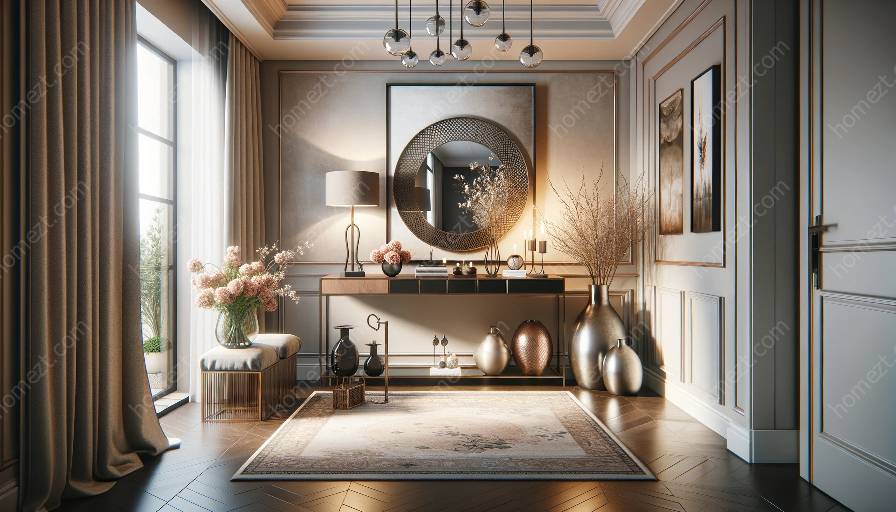Creating a stylish entryway involves more than just aesthetics; it's also an opportunity to incorporate sustainable materials that contribute to a greener and healthier living environment. From natural and recyclable materials to eco-conscious design choices, there are numerous ways to infuse sustainability into entryway decor and design. In this comprehensive guide, we'll explore how to integrate sustainable materials into entryway design while maintaining style and functionality, and delve into decorating ideas that promote eco-friendly living.
Understanding Sustainable Materials and Entryway Design
Before diving into specific design strategies, it's crucial to understand what constitutes sustainable materials and how they can be seamlessly integrated into entryway design. Sustainable materials are those that have been responsibly sourced or manufactured, minimizing their environmental impact and often offering additional benefits such as energy efficiency and durability. Common examples of sustainable materials include reclaimed wood, bamboo, cork, natural stone, recycled glass, and low VOC paints and finishes.
1. Utilizing Reclaimed or Recycled Wood
One of the quintessential sustainable materials for entryway design is reclaimed or recycled wood. Whether used for flooring, accent walls, or custom furniture pieces, reclaimed wood adds warmth, character, and eco-conscious charm to the entryway. Salvaged wood sourced from old barns, factories, or even sunken logs carries a unique history and patina, making it a distinctive choice for creating an inviting entryway. Additionally, opting for certified sustainable wood products and furniture made from recycled wood contributes to forest conservation and reduces the demand for virgin timber.
2. Incorporating Eco-Friendly Flooring
For an eco-friendly entryway, consider using sustainable flooring materials such as bamboo, cork, or reclaimed hardwood. Bamboo, a rapidly renewable resource, offers an elegant and durable flooring option that's also resistant to moisture and wear. Cork, derived from the bark of cork oak trees without harming the trees themselves, provides a soft, comfortable surface that's naturally anti-microbial and hypoallergenic. Reclaimed hardwood flooring not only repurposes wood but also contributes to the preservation of forests and reduces the environmental impact of new wood production.
3. Embracing Natural Stone and Recycled Glass
Integrating natural stone elements, such as granite or marble, into the entryway introduces timeless elegance and sustainability. Natural stone is durable, low-maintenance, and can be sourced in eco-conscious ways, such as through responsible quarrying practices. Another option for adding a touch of sustainability to the entryway is through the use of recycled glass for decorative accents, lighting fixtures, or even countertops. Recycled glass not only reduces the demand for new raw materials but also minimizes the amount of glass ending up in landfills.
Eco-Friendly Entryway Furnishings and Accents
In addition to architectural elements and finishes, selecting eco-friendly furnishings and accents is pivotal in achieving a sustainable and stylish entryway. Thoughtful choices in furniture, lighting, and decor can contribute to a healthier indoor environment and a reduced carbon footprint.
1. Choosing Sustainable Entryway Furniture
Opt for entryway furniture crafted from sustainable materials such as FSC-certified wood, bamboo, or metal with recycled content. Look for pieces that are designed for longevity and versatility, ensuring that they can adapt to changing decor trends and serve multiple functions in the entryway. Investing in high-quality, durable furniture not only reduces the need for frequent replacements but also minimizes waste generation.
2. Eco-Conscious Lighting and Fixtures
When selecting lighting for the entryway, consider energy-efficient options such as LED fixtures and compact fluorescent bulbs. Incorporating natural lighting through well-placed windows and skylights reduces the reliance on artificial lighting during daytime hours. Additionally, explore fixtures made from recycled materials or those with eco-friendly certifications, ensuring that they align with sustainable design principles.
3. Sustainable Decor and Greenery
Enhance the entryway with sustainable decor elements such as artwork created from recycled materials, organic textiles, and indoor plants that contribute to air purification. Choose decorative accents that are ethically sourced or handmade, supporting local artisans and promoting sustainable craftsmanship. By incorporating greenery and natural elements, the entryway becomes a welcoming and visually pleasing space that also contributes to improved indoor air quality.
Practical Tips for Sustainable Entryway Design
In addition to selecting sustainable materials and furnishings, there are several practical strategies to enhance the eco-friendly nature of the entryway while maintaining a stylish appeal and functionality.
1. Efficient Entryway Organization
Employ efficient storage solutions and organization systems that reduce clutter and promote a well-ordered entryway. Utilize multi-functional furniture pieces such as benches with built-in storage, wall-mounted shelves, and hooks for hanging coats and bags. By incorporating smart storage solutions, the entryway remains tidy and functional, allowing sustainable materials and design elements to shine.






































